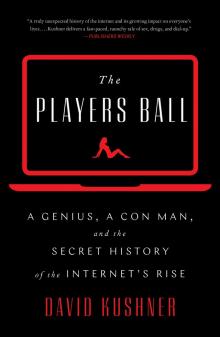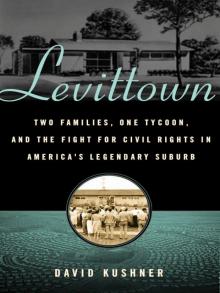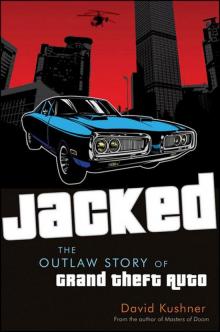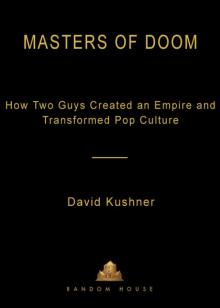- Home
- David Kushner
Alligator Candy Page 2
Alligator Candy Read online
Page 2
Instead of the usual square brick buildings, classes at IDS took place in a half dozen circular brown pods and, for the sixth- and seventh-graders, a giant yellow geodesic dome in the fashion of Buckminster Fuller. The Dome, as it was nicknamed, and the “Domies” inside, represented the pantheon of IDS-ness. Students aspired to the Dome and the day that they would become Domies. Walking inside the three-story-high building felt like entering a moon colony of Deadheads. Everyone seemed to have long, straight hair—the men and women, boys and girls—and some shade of bell-bottoms with patches of peace signs and rainbows. Instead of orderly desks and chairs, the room was a jumble of metal folding chairs and wood-paneled tables.
Inside the Dome, a colorful banner read “Happiness is like a butterfly: the more you chase it, the more it eludes you,” with the word butterfly represented by an illustration. The twenty-five-foot-high ceiling consisted of white insulation foam, porous but firm enough to catch the pointy end of a pencil chucked by some slack-jawed middle schooler and leave the pencil hanging there. Before long, all kinds of pointy supplies—protractors, rulers, and, most treacherously, sharp-tipped metal compasses—protruded from the entire ceiling. Kids would be sitting cross-legged in a circle discussing Frank Lloyd Wright with an earnest hippie instructor when a compass or pencil would loosen and plummet stealthily to the floor—or upon a head, arm, or lap.
The school was as groovy as white suburban 1970s groove could be. Its mission statement declared that “a happy child who is given respect as a unique human allowed to fulfill his needs to play, to investigate, and to be himself, is more open to learning than a child who is unhappy, tense, and fearful.” This philosophy had come from the founders, two grad students at USF trained in gifted education. Classes were designed around the British Infant Model, blending two grades as one and allowing these students to progress at their own pace.
In a symbolic gesture, someone removed the ringer of an old bell left on the property from its days as a farm because, as a caption beneath a picture of it in the yearbook noted, “traditional school bells never ring at un-traditional IDS.” This sort of holistic consciousness, or conscientiousness, extended to the weekly field trips, called “community classes.” As well as going to the local library, IDS students visited the local slaughterhouse to learn how meat was produced.
IDS attracted children of professors like my dad, as well as lawyers and artists around town. One kid came to school every day by paddling his canoe across the lake. Another had parents who let her choose her own name. She chose “Blackbird,” for the Beatles song; before that she was just called Girl. Students not only climbed the many trees, but also they spent classes there perched on branches. To earn money, kids would get paid to clean lettuce.
For my parents, the school felt like a progressive oasis, and they eagerly signed up Andy and Jon to attend. They bought a small ranch house with a red-tile roof close enough by that the boys could walk to school. A creek separated our backyard from the campus. When people would say how annoying it must be to hear the screaming kids all day back there, my mother told them that she loved hearing the children’s voices.
Jon and Andy were happy to join the chorus of these free-range kids. They ran around barefoot, built wigwams from fallen palm fronds, and gathered tadpoles at the lake during recess. The citrus groves became a steady part of the diet, and entertainment regimen. During softball games, the pitcher might clandestinely slip a grapefruit into her glove, lobbing it to the unsuspecting hitter, who, to his surprise, would smack it into a pulpy blast. To crack down on orange fights, teachers made a rule that any fruit thrown, even the rotten ones, had to be eaten.
Andy had taken up photography, and would shoot pictures of the kids forming a human pyramid up the Dome. Jon and his friends spent recess playing soccer or shoving one another into the pond—a convenient excuse for Jon to run home for a change of clothes. He might come back over the newly constructed bridge on the main road or, if he was feeling more like Huck Finn, balance-beam across the creek on one of the few wooden planks positioned there by adolescent explorers. After school, Jon and Andy would head up to the other nearby school to play H-O-R-S-E on the basketball court.
Jon became known as a quiet but thoughtful boy with a compassionate streak. One time, one of my brother’s friends fell from a tree, and Jon came to his aid. “You’re okay,” he told him, “just breathe deep. You got the wind knocked out of you.” Another time, Andy fell into a pond while looking for turtles and Jon readily helped fish him out.
But while Jon seemed to be finding his place among the kids and the teachers, he still struggled to get by in class. When the teacher dictated simple sentences for the class to write down, Jon’s paper would often be missing words. If the teacher said, “The quick brown fox jumps over the lazy dog,” he might just write “the quick fox dog.” Jon’s grades began to plummet, along with his self-esteem. At home, there were more frequent conflicts with Andy—like fighting over who got to sit in the front seat of the car. My parents sought the help of a psychologist, who established behavior modification plans, keeping tabs on the refrigerator as each boy completed chores so that he could earn the front seat.
The psychologist determined that Jon was suffering from an auditory memory deficit disorder—a sort of aural dyslexia that jumbled the words he heard. Seeking help, my parents sent him to a speech therapist for weekly sessions. Jon, like many ten-year-olds, put up a fight about going to see her after school but stuck it out. The speech therapist would read sentences to Jon and tell him to draw a blank line when he came to word that he couldn’t remember. They would then go back over the sentences until the blanks were filled. Before long, Jon began to improve. His scores jumped a full two or three grades in the span of eight months. My parents felt relieved as he brightened and gained confidence. Jon relaxed more during his visits with his speech therapist and began joking around with her. One afternoon, he brought her a gift: a small jar of dyed sand he’d layered like a rainbow.
5
THE HELICOPTER circled faster and faster, cutting the air with whirring blades. Down below, the astronaut drifted alone in a bright orange raft on a deep blue sea. His orange capsule bobbed nearby. The whirlybird lowered down, angling to pick up the astronaut and bring him to safety.
It was not long after we had moved to our new house in Tampa, and Jon and I were playing with our favorite toy, the VertiBird. Created by Mattel, the battery-powered toy promised “safe flying fun,” as the box read, by letting us “pilot real copter missions!” The small orange plastic copter with black blades was attached to a square white and yellow base by a long white spindle. To control the whirlybird, we pulled back or forth on two levers: a throttle and pitch control. The harder we pressed, the faster the bird went, occasionally careening into the blue shag carpet below.
The toy’s theme was inspired by the Apollo moon landings: you had to save the astronaut and his capsule from sinking. This rescue was achieved by lowering the chopper just enough to maneuver the skyhook through a tiny hoop on each of the scattered parts. The breeze and buzzing sound from the tiny blades were hypnotic, and I would twirl the helicopter as fast as it could go, speeding it recklessly into a storm, as Jon laughed harder than he could tell me to stop. Occasionally I’d ignore the sticker warning on the control unit to “Be a Safe Operator/Keep Behind Controls” and get smacked in the side of my head by the dull plastic blades. We found that hilarious.
Freedom and flight were the themes of Jon’s bedroom. It started with the VertiBird and extended to his walls. Wallpaper was everything at the time, a projection of our personalities, as if we’d swallowed a lightbulb that shone through our skin and tattooed the walls with our dreams. Our dreams—and our wallpaper—came in primary-colored pop art that was fashionable at the time. In my room, three walls were papered in red, yellow, white, and blue vertical stripes. The wall opposite my bed featured soldiers on horseback with faces like playing card Jacks. If I stared long enough at the soldiers w
hile I was falling asleep, they seemed to move. Andy, now a studious and aspiring thirteen-year-old musician, had a giant red arrow sweeping down his wall along with the words Start Here. He positioned his brown-sparkle drum set at the tip of the arrow.
Jon’s wallpaper was the trippiest of all, like some Roy Lichtenstein collage of illustrations or a scramble of images from Yellow Submarine. It featured a jumble of street signs—pedestrian crosswalk, yield, honk for curb service—floating over abstract swirls of colors, black-and-white-checkered optical illusion globes, and Hang Ten footprints. A sexy blonde woman wore a dress of yellow feathers that spelled the phrase “Not Now Darling.” The whole thing seemed like hippie hieroglyphics with a Freudian subtext. Alongside the woman was the face of a stern, mustachioed cop pointing his finger, with a stop sign beside him.
But there was no stopping my and Jon’s imaginations from taking off. When I padded barefoot into the room in my pajamas and flopped down on the shag, I had come to fly. Jon would briskly open his drawer and pull out our bible: a small black flight manual. It had been given to us by Mr. Landman, a friend of our parents who was an air force pilot. The book was even more cryptic than Jon’s wallpaper, full of numbers and codes and diagrams and maps and suggestions of another world—the world we flew into every time we pressed on the VertiBird levers.
I took extra interest in the VertiBird excursions because I was still too young to venture very far for real. The farthest I’d get would be the end of the sidewalk on my Big Wheel tricycle, but I had plenty of tantalizing woods to explore. Our house had been built on the lot of a tree nursery. The backyard teemed with podocarpus trees, which had thin, pointy leaves and small sour purple berries. Neighbors tore down their trees to build swimming pools, but my parents told the bulldozer drivers to keep away from ours.
My brothers and I were thankful the trees remained. We lost ourselves there, tunneling into the paths to play hide and seek. We had company in the backyard: a colony of pet turtles. They began arriving one day when one of us brought home a yellow-and-green-shelled box turtle found outside. Then came another, and another. To accommodate the growing herd, my dad dug a shallow hole in the back and filled it with concrete to make a pond. He fixed a green wire fence around the perimeter. Word got out, and other kids began bringing by errant turtles: snappers and tortoises. Soon we had nearly a dozen. We became known as the turtle family. The turtles were a great incentive for throwing out the garbage. Every night, my brothers and I fought over who would get to dump the half-eaten vegetables into their pen.
A creek behind the turtle pond led to an even wider and wilder world to explore. Because our house backed up against the woods, the paths seemed endless. After school and on weekends, we’d see skinny, long-haired kids in cutoffs and T-shirts dart by on their urgent adventures. Where they were going, I had no idea, but I was jealous that Andy and Jon were old enough to join them. I imagined them off in some incredible secret place, like the cove from my favorite TV show, Sigmund and the Sea Monster. The show was about this boy who, while off on his own neighborhood adventure, discovered a cave of friendly sea monsters: Sigmund, the nice one, and his mischievous brothers Burp and Slurp.
The sea monsters were just actors on some Hollywood lot, sweating inside big, rubbery green costumes, but I was still young enough to suspend disbelief. The fact that the show’s hero had red hair and was named Johnny made it even more compelling. Maybe my own red-haired brother Jon would find Sigmund beyond the creek and bring him home to play with our turtles and VertiBird, I imagined. Kids spoke of secret caves in the woods across the street from our house, not far from the 7-Eleven.
6
NINETEEN SEVENTY-THREE was a peak year for my family. My parents both turned forty. After spending most of their adulthood moving from city to city, they could finally get used to calling Tampa home.
My dad was living his dreams at work. His PhD dissertation was published as a book, Immigrants from India to Israel, his first. Someone snapped a photo of him in his office, holding up the book with his left hand while reaching over his head and playfully pointing at it with his right. His hair and beard were long and black, and he wore tinted aviator shades. He looked like a cross between Allen Ginsberg and Tommy Chong (a comparison that he prided himself on). One of my pre-K finger paintings—a Halloween-themed piece of thick-limbed stick figures and a smudgy witch—hung on his wall behind him.
Under his leadership as chairperson (the more egalitarian term he used instead of chairman), the department was receiving international attention for launching the first master’s program in applied anthropology in the world. Applied anthropology took academics out of the ivory tower and into the field, exploring ways in which they could apply their training to practical problems, from urban planning to public health. The master’s program, which would begin in 1974, kept very much in line with my dad’s history of social activism; at the same time, it was considered heretical by those who thought that anthros—as my dad and his colleagues referred to themselves—should stay in the classroom.
But it fit the radical times. Not long before, students at my dad’s university, USF, and others had staged a massive protest nearby that blocked a major intersection and ended with local police firing tear gas into the crowd. The Watergate scandal was now dominating the news. A peace treaty had been reached in Vietnam, though the horrors of the conflict still lingered.
While my dad fought for his program, my mother, who worked part-time, was fighting to empower women in childbirth. Nurses invited her to come to the hospital to teach Lamaze to their mothers, but when one doctor found out, he wrote my mother an angry letter, stating, “You have no right going into my hospital in a sterile area.” My mom didn’t back down. “I didn’t plan this,” she told him. “Your nurses invited me.”
A local reporter came to write a story on my mom’s classes, the first of their kind in Tampa. Soon more nurses began contacting her, one influential woman in particular. “She said, ‘You’re here, I know what you’re doing, I heard about Lamaze,’ ” my mother recalled. “ ‘We’re going to back you up.’ ” As my mom held more and more classes at our home, Andy, Jon, and I got used to opening the front door to pregnant women. My dad once joked that the other men in the neighborhood must have been impressed—or dismayed—by all the expectant mothers with pillows arriving at our house.
Because my parents were so engaged in their causes, they felt an even greater sense of community with their colleagues and friends. Parties at our house became regular occurrences, especially because my dad had to host visiting faculty when they passed through town. I spent many nights weaving through blue-jeaned legs and paisley dresses, as Cat Stevens records played on the turntable. Outside on the patio, I’d spy small clusters of artists, professors, actresses, and teachers passing joints and laughing. The celebrations peaked in March 1973 with Andy’s bar mitzvah. By thirteen, he had already found his passion, playing trumpet, and was showing exceptional skill in his school bands. Compared with Jon and me, Andy had an incredible sense of dedication and could spend hours in his room practicing his horn.
That summer, as my parents celebrated another wedding anniversary, Jon was finding his place too. He was attending Camp Keystone in a patch of woods fifteen minutes from our house. With his school troubles fading behind him, my brother reveled in the freedom of camp, playing soccer, reading comic books, and having water pistol fights. He recorded him and his friends on his cassette tape recorder, showing off his Donald Duck impression. They photographed one another shirtless, shooting birds with both hands, their middle fingers raised. Jon was growing up.
For Jon’s eleventh birthday, September 13, 1973, the family took him to his favorite pizza place, Shakey’s, where he joked around in the birthday hat with his friends as he relished having an entire pizza to himself. Back home, Jon opened our front door to find a delivery man standing alongside a shiny green Schwinn bicycle. It was a gift from my parents, who knew how much he loved riding his bik
e. With him growing taller and lankier, they figured it was time for the next size up. Jon eagerly took the bike for a spin, pedaling down the driveway to the street, feeling the familiar rush of wind and motion. My parents ran outside with a camera and snapped a black-and-white photo of him there, the same kind of picture that has been taken by parents thousands of times before and since: a happy child riding a new bike for the first time.
7
OCTOBER 28, 1973, began like any other Sunday. Andy woke up early to go to a youth group meeting at our synagogue on the other side of town. He sometimes carpooled with a local teenager whom he never really liked. He and Jon had made a game out of his dread, hiding by the window and peaking outside as they heard the car pull up. On this day, they let their inside joke go further than usual, and, unbeknownst to my parents, pretended they didn’t hear the door when the boy came knocking. Andy figured my mom would just drive him instead, which she did.
But it was going to be a busy day. That night, my parents were hosting a dinner for the social club at our synagogue, Havorah. Though immersed in university and IDS life, they were hoping to build up their community at shul, and this dinner was the start. After Andy and Mom left, Jon went outside to mow the lawn. The grass, even in the fall, grew quickly and thickly, and my dad encouraged Andy and Jon to take turns mowing to earn their allowance.
By around noon, when Jon was done, he asked my dad if it was okay to bike to the 7-Eleven to buy some candy. It was the same ride he’d taken countless times, just like all the other kids in the neighborhood. My dad said okay and settled into his big black chair in the den to catch the Minnesota Vikings–Los Angeles Rams game on TV, a formidable battle of two undefeated football teams.
Jon slipped on his red, white, and blue Hush Puppies and went into his room, where he took a dollar from his wallet. Then he headed out to the garage and grabbed his old red bike. As he pedaled down the driveway and turned right onto the sidewalk toward the woods, I trailed after him until he stopped. We had that conversation about the candy I wanted, the Snappy Gator Gum. And then he was gone.

 The Players Ball
The Players Ball Alligator Candy
Alligator Candy Levittown
Levittown Jacked: The Outlaw Story of Grand Theft Auto
Jacked: The Outlaw Story of Grand Theft Auto Masters of Doom
Masters of Doom